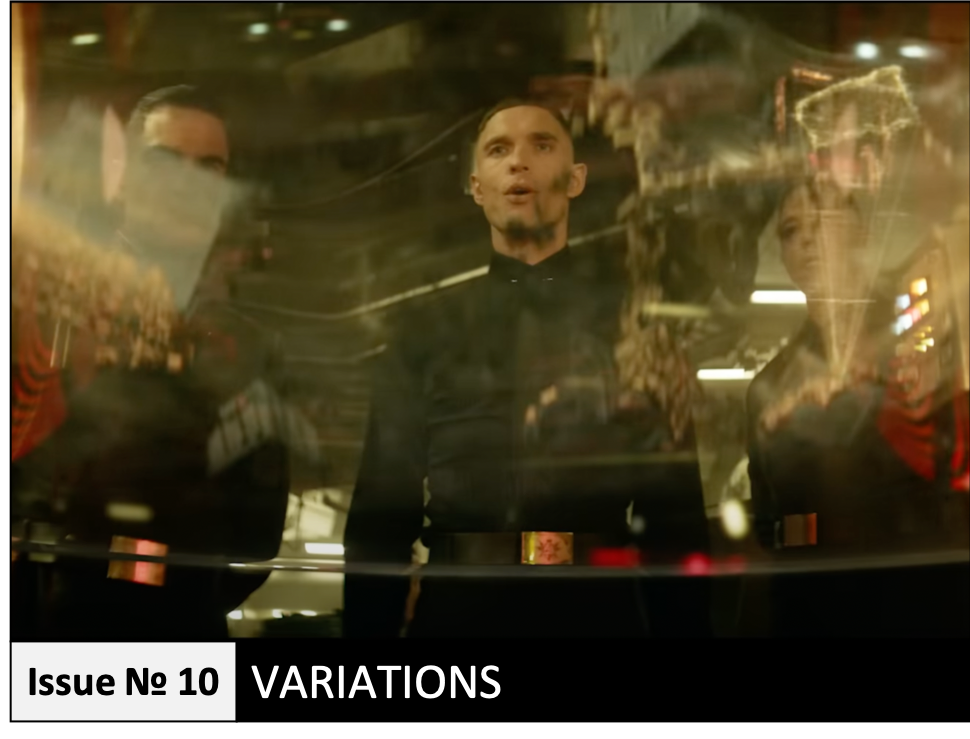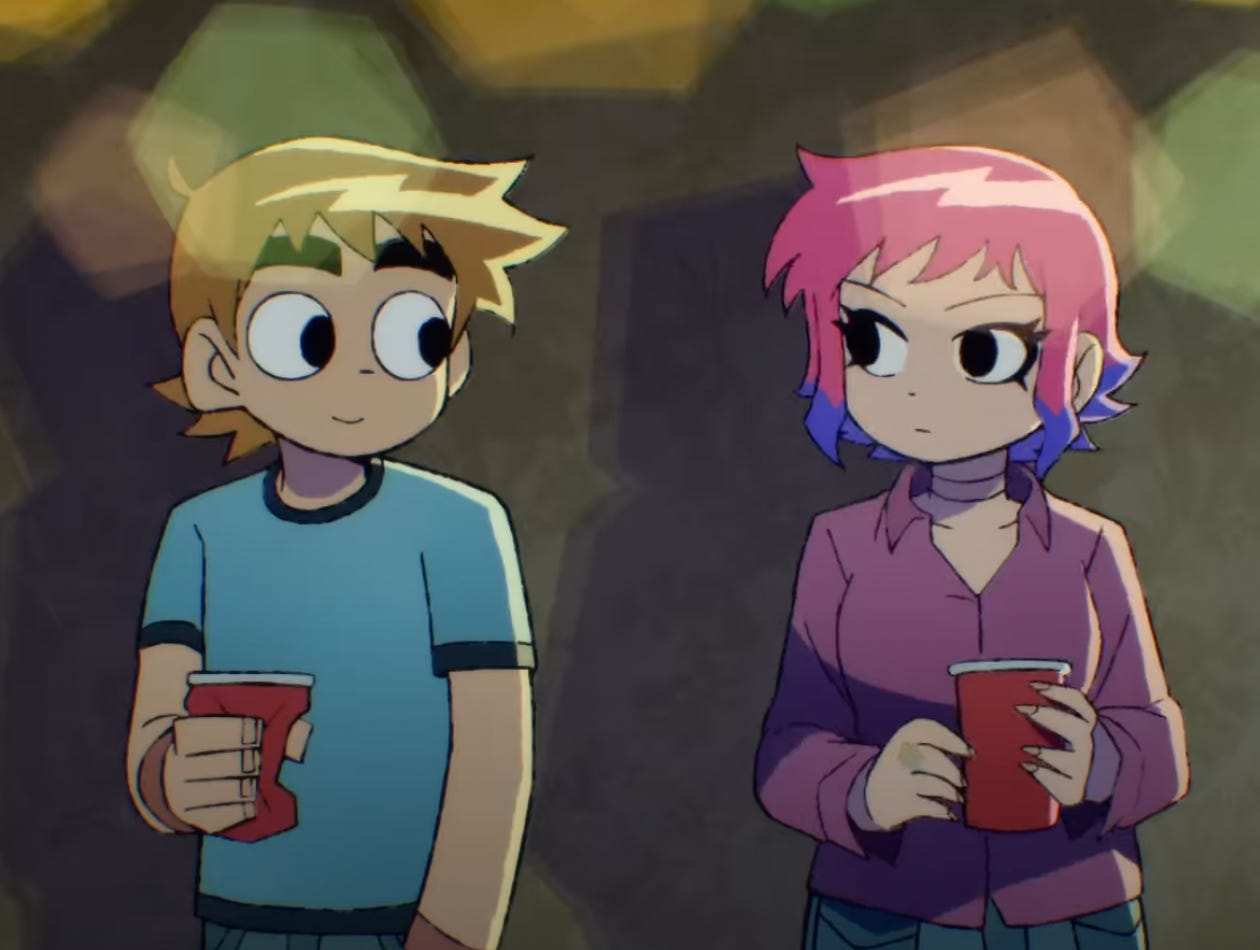'Rebel Moon' Part 2 is an Underrated Gem
Plus: Table of Contents, Schedule Changes, and Scott Pilgrim.
In this article, I want to primarily talk about why I think the second part of Zack Snyder’s Rebel Moon is a good movie in addition to some other things that I can’t really seem to fit into other newsletters.
Table of Contents‘Rebel Moon Part 2’ Doesn’t Skimp on Connective Tissue
There’s a small scene towards the end of Zack Snyder’s Rebel Moon Part 2 that, for me, exemplifies why this is a much stronger installment than its immediate predecessor.
Admiral Noble and his second-in-command Cassius discover that Kora is aboard their ship. Convinced that capturing or killing Kora now takes precedence over everything else, Noble orders Cassius to open fire upon the Veldt village.
His commander protests. After all, bombing the Veldt would destroy all the precious grain Motherworld’s forces came here to collect. Noble dismisses this by claiming that the grain no longer matters, as Kora is the bigger prize.
Cassius then rightfully points out that they would be killing their own soldiers, who are still on the ground trying to take the village. Noble coldly replies that now they will have ‘less mouths to feed.’ And so the commander gives the order to fire.
This is very simple storytelling that tells us everything we need to know for the story to make sense, as well as explaining exactly what each character wants and why, allowing for the film to work on both a plot and character level, thereby upholding audience immersion in the picture.
One can thus argue that nothing that occurs in this scene is at all remarkable.
But I found it fascinating, because the entire film up to and including this scene has been remarkably coherent in both layers of storytelling, something that is not really all that common for Zack Snyder. Whether due to script issues or excessive editing in post-production, many of his movies eventually come to suffer from visible plot holes, and unconvincing character actions due to missing connective tissue.
At one point in the mostly great Man of Steel, for instance, the villainous kryptonians decide to take Lois Lane aboard their ship. Plot-wise , this positions Lois where she needs to be for other story beats to happen but this is never really justified or motivated in terms of character. Never once does the script bother to explain why the Kryptonians needed her or what they hoped to achieve by hooking her up to their memory machine, or what the experience actually does to her.
Rebel Moon Part 1 had multiple instances like this that broke immersion.* Early on, for example, it introduces the characters of Jimmy and Aris, who seem like they’re being set up as important protagonists, but following the crucial turning point where Kora takes out the Motherworld soldiers, the film fails to provide any clarity, as to where exactly these characters stand, and seemingly abandons their story.
*I’m not even going to get into the weird structural issues. At least, not in this post.
Logically, there should’ve been a scene that established what these characters want and what relationship to Kora and the farmers actually is, now that the Motherworld occupants are gone. Are they joining forces with Kora? Will they help the Veldt? Will they decide to run away and try to survive by themselves? Do they trust Kora and does Kora trust them? None of these questions are answered, and so these characters’ motives and roles are left completely vague.
But by far though, the most immersion-breaking moment for me was the one where Kora tried to recruit Darrian and Devra Bloodaxe to her cause by blatantly LYING to them about how they’re responsible for what Noble is doing to the Veldt.
The problem isn’t that Kora lies here. It’s that the film provides no acknowledgement of the fact that she lied. The scene and the actors, in other words, did not play it as though she knowingly lied, which was really distracting and confusing.*
*There was no shot of Gunnar, for example, turning and giving Kora a concerned look when when she claim that Noble came to Veldt due to Gunnar selling wheat to the rebels.
As it turned out, that’s because she didn’t lie originally.
As revealed by the novelization, when Admiral Noble murdered the village leader Sindri, he was supposed to reveal that he knows that someone from the Veldt has actually been selling surplus wheat to the rebels he is hunting, and this is why he had targeted their village. This made Gunnar directly responsible for putting the Veldt in danger, and thus key to his motivation: to make amends for his mistake.
Snyder had apparently cut this crucial moment of connective narrative tissue from that scene, but then bafflingly left the reference to it in the Bloodaxe scene.*
*As this makes no sense from a storytelling standpoint, I’m going to chalk it up to Snyder simply neglecting to spot the narrative discrepancy in the editing room. Hopefully then, Snyder will restore this missing piece of crucial narrative information to the R-rated cut.
Part 2, thankfully, has no such instances and so is essentially what I wish Part 1 had been - a predictable yet very well executed sci-fi action picture that remains immer-sive from start to finish. I really like how its first hour builds up to the point of an all-out battle between the farmers and the fascists, and then just delivers on the action.
It is not uncommon nowadays for blockbusters to cut back on their action sequences or rush through them (likely due to time and budget constraints), or not really give viewers a proper sense of what is happening and where and why.
The Scargiver, meanwhile keeps things crisp and clear, sustaining its big battle for something like a good 40 minutes or so (I don’t remember how long it really is tbh). That it manages to do that while adhering all throughout to emotional realism, without making anything seem forced or contrived, makes it for me not only a legitimately good movie but also one of the best Zack Snyder movies.
I don’t know the future of the Rebel Moon franchise or universe, but I can definitely say after seeing Part 2 that I’d be sad if this indeed were the final installment.
BONUS MATERIALSI’ve Updated My Substack Table of Contents Guide
Arguably my most popular article is a short guide to making a Table of Contents on Substack. Since I first published it in November 2022, it’s gotten over 4000 views, 50 likes, and a whole lotta comments.
Well, about a week ago, I received a new, somewhat angry comment about my post that essentially boiled down to the idea that it lacked clarity.
Having looked my article over again and re-read some older comments, I realized that my guide indeed had some places where things were a little confusing or unclear.
So, I decided to revise it, while also addressing some other commentators’ notes about alternative ways of adding a TOC. I really like the new version and hope it indeed helps other writers who wish to utilize TOCs. Hopefully, at some point, the platform will introduce the option to ‘add a TOC’ to your article in the publisher interface.
On ‘Scott Pilgrim Takes Off’
In 2010, I saw Scott Pilgrim vs. The World (dir. Edgar Wright), a weird, super-stylized, over-the-top movie that was nonetheless was full of heart. I believe I initially thought it was an unapologetic videogame adaptation.
I mean, it takes place in a reality where the main protagonist (Michael Cera) has to literally fight superpowered bad guys until they burst into coins, all in order to date a girl that had 7 ‘evil exes,’ and nobody bats an eye. To my surprise, it wasn’t based on a game but a comic, though I’m still thinking it qualifies as a videogame movie.
Despite great critical reception and huge early buzz, Pilgrim bombed at the box office, only to build up a reputation as a cult classic over time. Flash forward to 2023, and we got Scott Pilgrim Takes Off, an eight-episode anime series that can be seen as both a new take on and a stealth sequel to the movie and/or the comics.
This means that if you’re not familiar with the source material or the previous adaptation, you can definitely enjoy it but the familiarity does help as the series is in dialogue with what came before. Its title provides a good idea of how it means to distinguish itself from what came before. Though the show starts off in a familiar place, it very quickly relegates Scott to a secondary role and instead turns Ramona Flowers (Mary Elizabeth Winstead) into its true main protagonist.
Though there is a central story arc, most of the episodes focus on Ramona’s relation-ship with a specific ‘evil ex’ from her past, allowing every installment to more or less stand alone.Having seen all 8 half-hours, I can tell you: I love this show.
In fact, I think it’s better than the movie. I prefer its less bombastic, less visually overloaded style. The pace is slower and there is way more breathing room to delve into the character relationships and enjoy the many, many visual details that this show throws at you. Takes Off really embraces the idea of being an anime and plays to that format in ways the live-action film couldn’t. So, the world of the series is somewhat less videogamey and more animated, if that makes sense.
And the animation is downright gorgeous.
There are plenty of standout sequences but if I had to highlight one, it would be Ramona’s trippy duel with Roxy in Episode 3, with the two starting their fight in a video store before inexplicably traveling inside different movies to battle across cinematic landscapes. (It makes sense in the context of the show, trust me.)
Btw, if anyone is interested in reading episodic coverage of the series, I recommend checking out the recaps by Spencer Irwin at
Spencer does some really nice analytical deep dives into the series and its relationship with both the original comics and the film adaptation.
Changing the Schedule
Finally, there’s some site news. At the end of May, T.V. will switch to a bi-weekly publication schedule, meaning new articles will, as a rule, come out every two weeks.
The way I’m looking at it now, the bi-weekly approach will last from June 11 until the end of August. This should help me avoid the long publication lags that tend to happen during Summer months, when my writing time is considerably diminished, as well as allow me to focus on completing several longform posts that I’d worked on earlier this year before external events disrupted my progress.
Come September, I’m planning to return to a weekly schedule.
But who knows? Maybe I’ll enjoy the new approach so much that I’ll stick with it a while longer. We’ll see what happens.
Seriously, how do Substack writers stick to a consistent publication schedule for the duration of a whole year? Any thoughts on Rebel Moon or Scott Pilgrim, or making TOCs? Have any thoughts on the new Dhulmax streaming bundle? Please,




I've been wanting to watch this one! Will check out your review once I do